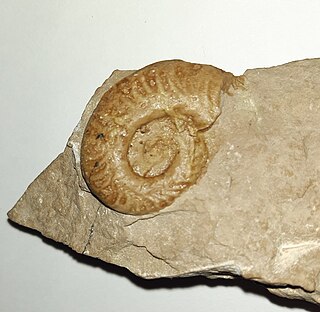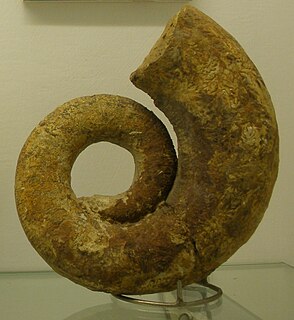
Stephanoceras is an extinct genus of Stephanoceratoid ammonite which lived during the Bajocian. It is the type genus of the family Stephanoceratidae.
Abbasites is an extinct genus of ammonites from the early Middle Jurassic epoch, included in the ammonitid family Erycitidae.

Xipheroceras is a Lower Jurassic ammonite belonging to the Eoderoceratidae, and sometimes placed in the subfamily Xipheroceratinae for which it is the namesake. It has been found in the upper Sinemurian of Europe and possibly Borneo.
Alocolytoceras is a lytoderatid ammonite with whorls that pass during growth from round to oval, rounded-quadrate, or compressed; with about 19 deep constrictions per whorl, with as many as 21 sharp ribs in between. The shell is evolute. All whorls are visible from either side.

Audaxlytoceras is an extinct genus of lytoceratid ammonites.

Arnioceras is an extinct genus of large, evolute, discoidal ammonite from the Lower Jurassic. The shell is normally coiled so that all whorls are exposed. Sides bear strong sharp ribs that are straight until reaching the ventrolateral edge where they swing forward and fade. The rim (venter) is keeled and free of grooves.
Berniceras is an extinct ammonite genus from the order Ammonitida that lived during the early Oxfordian stage of the Late Jurassic. Berniceras is included in the ammonite family, Oppeliidae.
Euaptetoceras is an evolute hildoceratoid ammonite from the lower Middle Jurassic, included in the family Hammatoceratidae and the subfamility Hammatoceratinae. The genus may be a junior synonym for Eudmetoceras of Buckman, 1920.
Ermoceras is a genus of ammonite belonging to the Thomboceratidae family of the Middle Jurassic found in deposites of central Arabia, Sinai, and Algeria with strong primary and secondary ribs and a single row of lateral tubercles; described as having a deep ventral groove
Duashnoceras is an extinct ammonoid cephalopod genus included in the Stephanoceratidae that lived during the Bathonian stage of the Middle Jurassic.
Parastrenoceras is an extinct genus from the ammonoid cephalopod order Ammonitida, included in the family Spiroceratidae that lived during the Bajocian stage of the Middle Jurassic.
Otoites is the type genus of the ammonite family Otoitidae that live during the Middle Jurassic.

Normannites is a strongly ribbed evolute Middle Jurassic genus of ammonite included in the stephanoceratoid family Stephanoceratidae.

Hildoceras is a genus of ammonite from the Jurassic period in the family Hildoceratidae. The shells are characterized by a narrow discoidal evolute shape, keeled venter, concave ribs along the outer flanks, and a shallow spiral groove running along smooth inner flanks. Whorls slightly overlap, cross sections are compressed. The ventral keel is bordered on either side by a shallow groove. The genus was named by Alpheus Hyatt after Saint Hilda in 1876.

Bostrychoceras is a genus of heteromorph ammonite from the family Nostoceratidae. Fossils have been found in Late Cretaceous sediments in Europe and North America.
Subcollina is a genus of evolute to serpenticonic stephanoceratacean ammonites from the Middle Jurassic (Baj) of Mexico, placed in the family Spiroceratidae.

Macrocephalites is a genus of the stephanoceratoid ammonite family Macrocephalitidae, diagnostic of the Callovian stage of the Middle Jurassic. Three subgenera, Dolikephalites, Kamptokephalites, and Pleurocephalites are recognized in addition to Macrocephalites itself, with Indocephalites tentatively included as the fourth.
Eoderoceras is an evolute, round whorled ammonite from the Lower Jurassic with an outer row of distinct spines, and in some, an inner row of tubercles, on either side; ribs only on the inner whorls.

Lytoceras is an ammonite genus that was extant during most of the Jurassic and Cretaceous periods, and is the type genus for the family Lytoceratidae. These cephalopods were fast-moving nektonic carnivores.
Ochetoceras is a genus of ammonites, belonging to the Oppeliidae, that lived during the Late Jurassic from the early Oxfordian to the early Tithonian, and type for the subfamily Ochetoceratinae.








